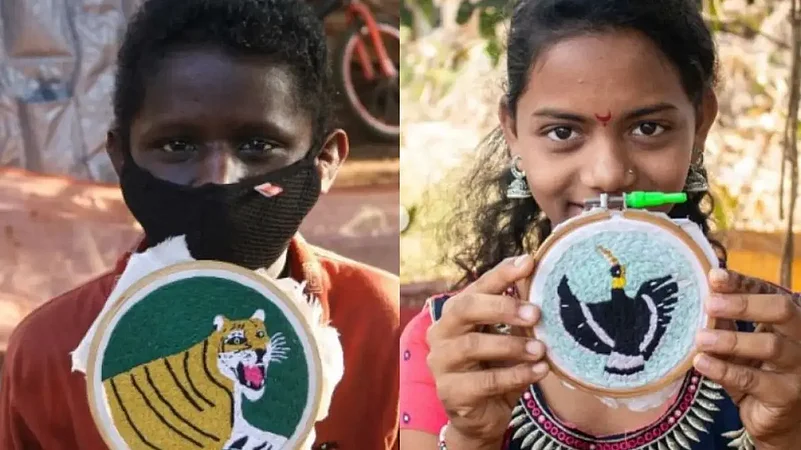In a small village in Kolhapur, 14-year-old Rahul had been struggling with his studies for a few years. He had been labelled a ‘slow learner’ owing to his inability to cope with mainstream education’s demands, which put him on the receiving end of remarks that deterred the teenager from attending school altogether.
What shone bright in the boy was a desire to observe his environment and learn from it. Over his last three years at Insight Walk’s Solidarity Art Farm in his village, Rahul spent time learning more about the birds and animals in his community, gathering knowledge from his elders to put together a book on fauna diversity. Now 17, Rahul hopes to be a wildlife conservationist and inches closer to his dream as he teaches hundreds of kids in neighbouring villages about climate change and its impact on animals.

Rahul is not the only one. Vaibhavi, who lost her mother at a young age and saw her father abandon her after he married another woman, stays with her maternal grandmother in the village. Inspired by her grandmother’s hard work, she decided to document her life, and the lives of other rural women through mediums like crochet, chalk carving, pencil carving, embroidery, painting, miniature art using tissue papers and waste papers, at the farm. Youngsters like Vaibhavi interview and spend time with the community women, most of whom toil as agricultural labourers. They hope to not only archive the efforts of their elders but also find out ways to mitigate the gender bias that plays out in rural economies.
Neither could achieve what they have in their schools. Subjects like Maths, Science, Geography make sense on paper, but do they make sense to the kids in villages for whom the ideas that leap out from the books are not rooted in their reality?
Can every child learn the same thing in the same way?
***
Almost 70 percent of India lives in villages. Millions of children from rural India cannot build a career of their choice owing to the unequal distribution of opportunities and resources. What makes matters far more complicated is the standardised education system that fails to take the rural ecosystem into context. It is here that Insight Walk hopes to make a difference.

Insight Walk started its first centre in a small hamlet of Dhakale in Bhadole village, with a handful of students in 2017. Today the Solidarity Art Farm Museum, as the centre is called, is a space for over 100 kids to pick the problems of their choice and figure out their solutions. Founded by Subodh Jain, the non-profit organisation aims at aligning rural education with experiential learning that takes inspiration from the learner’s environment. Rahul and Vaibhavi are two of the 400 students at centres in four villages of Kolhapur’s Hatkanangale who design their own syllabus with a major focus on curiosity, low-cost innovation, problem-solving, and creativity.
One of the first things that stand out in a rural educational setup is the gender gap. Bridging it was one of the first directional aims of Insight Walk. “We understood that gender roles played out in the villages in very general ways. Women ran the household, and if kids had to be sent to school, then it was the boys who were given the opportunity. Girls would often stay back and tend to the farm,” explains Subodh. At their open-air community centre, the duo has tried to break this mould in two ways.

Four local women, part of a rural fellowship program at the initiative, teach children from their respective villages at the centres for a monthly salary, with support from other women volunteers. Subodh believes all interventions need to be rooted in the ecosystem’s understanding. “Women often have to drop out from their schools and colleges due to financial constraints, early marriage, patriarchy, gender inequality and a myriad of other reasons. These individuals, who often have day jobs as labourers or stay at home, have taken up the fellowship and contribute to educating the kids of the area,” the 30-year-old founder says.
The centre, meant to operate as an outside-school intervention, is open 365 days a year and runs from early morning till midnight, allowing kids to walk in at any time. This was done to ensure girls could come in and study as per their convenience. “Why should education have any set timings?” Subodh muses. There are no blackboards at the farm. An open space lets kids between the ages of 6-14 work together, choosing their own subjects on a daily basis.
Trash is Treasure
In school, I was good at English but Mathematics would make me drop into a puddle of tears every day. My sibling found grammar to be harder than Chemistry but would draw the most beautiful portraits. Every child is different and one standardised educational system can’t ensure equal learning opportunities. At Insight Walk’s Solidarity Art Farm, organic learning is promoted, without the burden of competition. This is ensured by a plethora of programs that run simultaneously, focussed on inculcating different skill sets in the local students. At the heart of all the programs are sustainability and environment.
“Rural communities often implement the most sustainable and environment-conscious initiatives. While in urban cities, kids learn science in classrooms, but for a child in the village, the best way is to teach them from examples around them. Trash is treasure here. Children make toys and other useful resources using locally available trash and materials. This helps push their creativity to build solutions that are easily sourceable,” Subodh adds. Dhakale’s Solidarity Art Farm Museum is home to many such innovations that lie at the intersection of art, science, agriculture and wildlife conservation. A four-feet tall Vulture Art installation, made entirely from scrap, hopes to draw attention to the dwindling population of the bird in the area. It also acts as a support for several climbers and creepers in the field.

The interventions are not limited to the art farm. A hands-on approach has translated into a greater interest among the kids at the centre towards applying their knowledge to their environment. “During our fieldwork, we found out that most farm tools are not ergonomically designed and do not cater to impairments. Something as basic as a fertiliser spreader can cost thousands while our students designed a low-cost efficient model for ₹150! Similarly, when kids saw women being overburdened with the work of peeling peanuts, they designed a prototype that could compete with a standard manual peanut peeler which costs around ₹15,000 in the market. All scientific innovations at the Solidarity Art Farm point towards the fact that technological interventions need to be affordable and also emerge from the communities that are impacted by them the most,” adds Subodh, with a hint of pride.
With lack of access to basic amenities, village communities are also driven by the idea of self-dependence. To ensure the young learners here have elementary skill sets that will help them be independent, they are taught embroidery and sewing, farming and 25 other skills.
Contextual Education And Sustainability
At Insight Walk, most of the children come from families who are daily wage earners and agricultural labourers; many belong to displaced families that were forced to migrate because of the Chandoli National Park project. Susceptible to vagaries both man-made and natural, village communities are the first ones to be hit during a catastrophe. Still reeling under the effect of the floods of 2019, most families in these villages were once again left without work and at the mercy of external help during the coronavirus-induced lockdown.

The location adds to the woes. Kolhapur is a mono cropping district with sugarcane as the primary crop. A water intensive process, sugarcane farming also leaves the land devoid of nutrients due to excessive chemical use. Perturbed by their recurring problems, the children in the area took it upon themselves to question existing farming practices, reaching out to their grandparents for information about organic farming. Insight Walk emboldens their efforts; they took up the challenge of eliminating hunger crisis after the 2019 floods, merging it with education and sustainability. The aim? To create community-led initiatives that can be replicated and implemented everywhere.
To deal with scarcity of food, farming in alternate spaces is encouraged; students at the Solidarity Art Farm practise vertical farming, planting vegetables in discarded resources such as fallen coconut fronds so as to maximise production. A seed bank is also in the works, where indigenous seeds are collected and then supplied to farmers in the area. During the lockdown, the children at the art farm supplied vegetables like spinach, coriander, lemongrass, turmeric powder that they had cultivated to those in need, helping them sustain for at least two weeks.
Within two years of practising organic farming, the young villagers managed to increase their crop variety from 10 to 25 in early 2021, ensuring their designs were flood and drought resistant. In July 2021, the district was impacted by floods once again but this time around, with production maximised, there were enough resources to go around.
To ensure that this acquired knowledge is available to future generations, an open space community library acts as an archive of best farming practices and community wisdom, where kids document their day to day life through skills like stitching, hand embroidery, photography, story writing, painting, poetry and illustrations. Some of the materials in the library include a hand embroidery book on the life cycle of crops which they have cultivated, a book on limitations of traditional farming equipment and their modern day affordable alternatives, a book on making organic colours and organic fertilisers and a book on mixed farming.
Vanishing Livelihoods and Dying Art Forms
13-year-old Puja always wanted to learn hand embroidery, but was told the skill had no future. While she couldn’t pursue her ambition in school, she chose to work on the skill at Insight Walk, spending 1.5 years and over a 1,000 hours mastering the craft. She is now a mentor to younger kids in her community. The same skill is now helping students create a book on endangered birds and animals using hand embroidery.

Subodh, whose focus on alternate contextual education has helped the villages tackle varied challenges, lists the key factor that has transformed four Kolhapur villages into centres of education, sustainable solutions, while archiving the lives of rural India. “Over the last five years, we have encouraged children to choose their own curriculum and their own teachers and mentors. If a child wants to learn how to carve wood, they go to the local artisan and seek mentorship,” explains Subodh. This in turn, adds more skills to the curriculum, such as the Vanishing Livelihoods and Dying Art Forms subject, which was inspired by the artisans who have spent decades mastering their crafts.
One such individual is Laxmibai Dhangar, a 72-year-old artisan who has been handspinning thread from sheep hair and wool which is used to make Ghongadi (blanket), an artform that is now practised only by a handful of women. Spending 120 hours, students at the art farm paid homage to her talent through hand embroidered artwork. “While students learn a skill (embroidery in this case), they also understand how and why many art forms are on the verge of extinction. Instead of studying conventional subjects, picking subjects of their own choice provide these kids the opportunity to learn more about their own society,” Subodh elaborates.

The non-profit sustains itself on individual donations; they also use crowdfunding to provide art, science, embroidery and other education kits to kids in the villages. Jain, who holds a degree in computer science, is also working with local communities in the villages of Mangaonwadi, Golivane and Sonarli. From making visual books that document the lives of rural women to creating a dam that stores water for periods of drought, learning at the centres continued even in the face of the pandemic. While the world tried to move to e-learning, Insight Walk decided to explore alternatives, and let its communities take the reins on how they wanted to learn. They eradicated hunger with sustainable solutions, worked on understanding the care economy and made scientific innovations to deal with everyday struggles.
All this was the work of ordinary rural kids who had been allowed to learn what they wished to learn. A rigid education system that fails to take into account the needs and aspirations of its people is antithetical to learning, and if Insight Walk teaches us anything, it is how focusing on curiosity-led learning models is an innovative way to bring around systemic changes in the hinterlands of India.


























